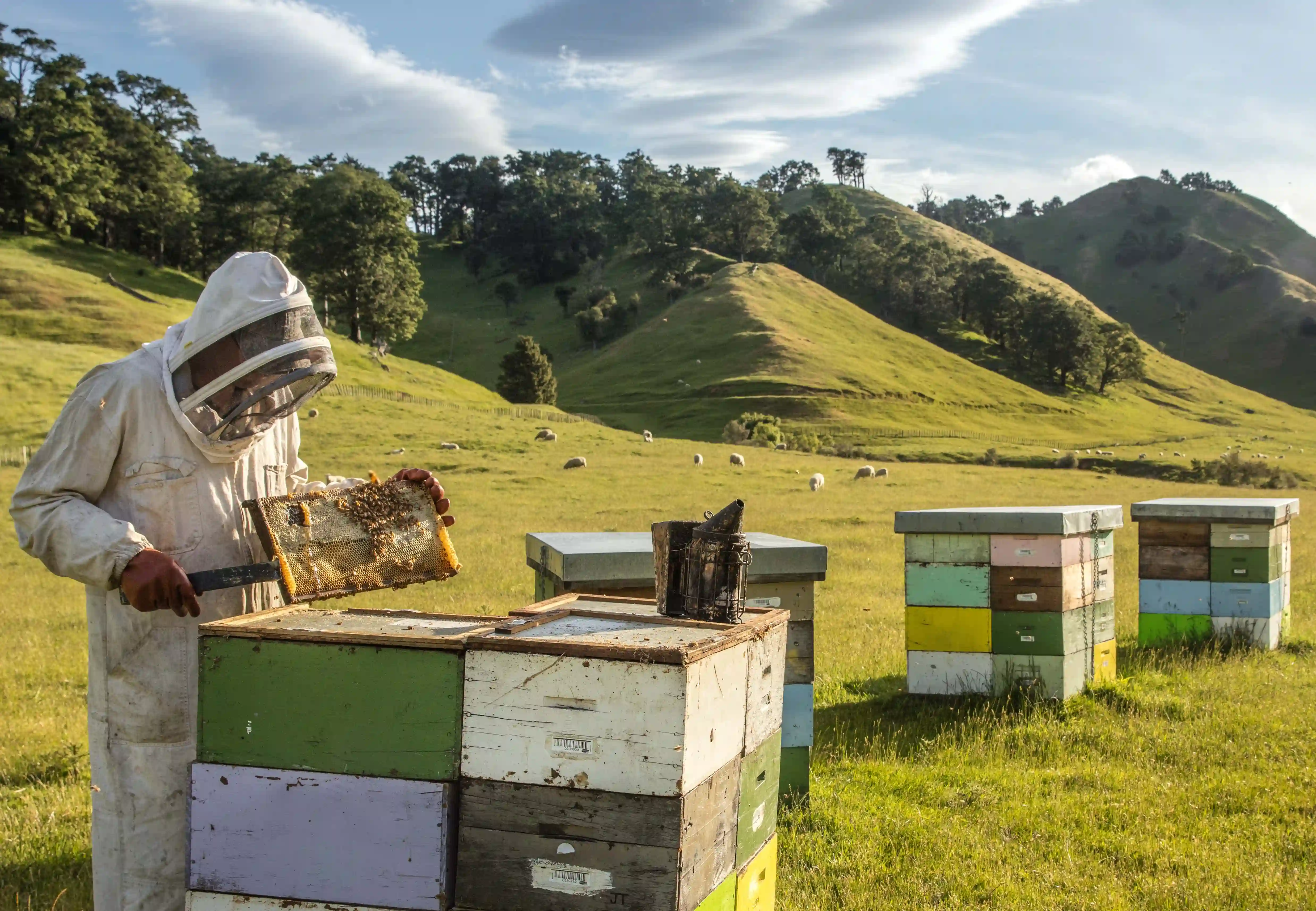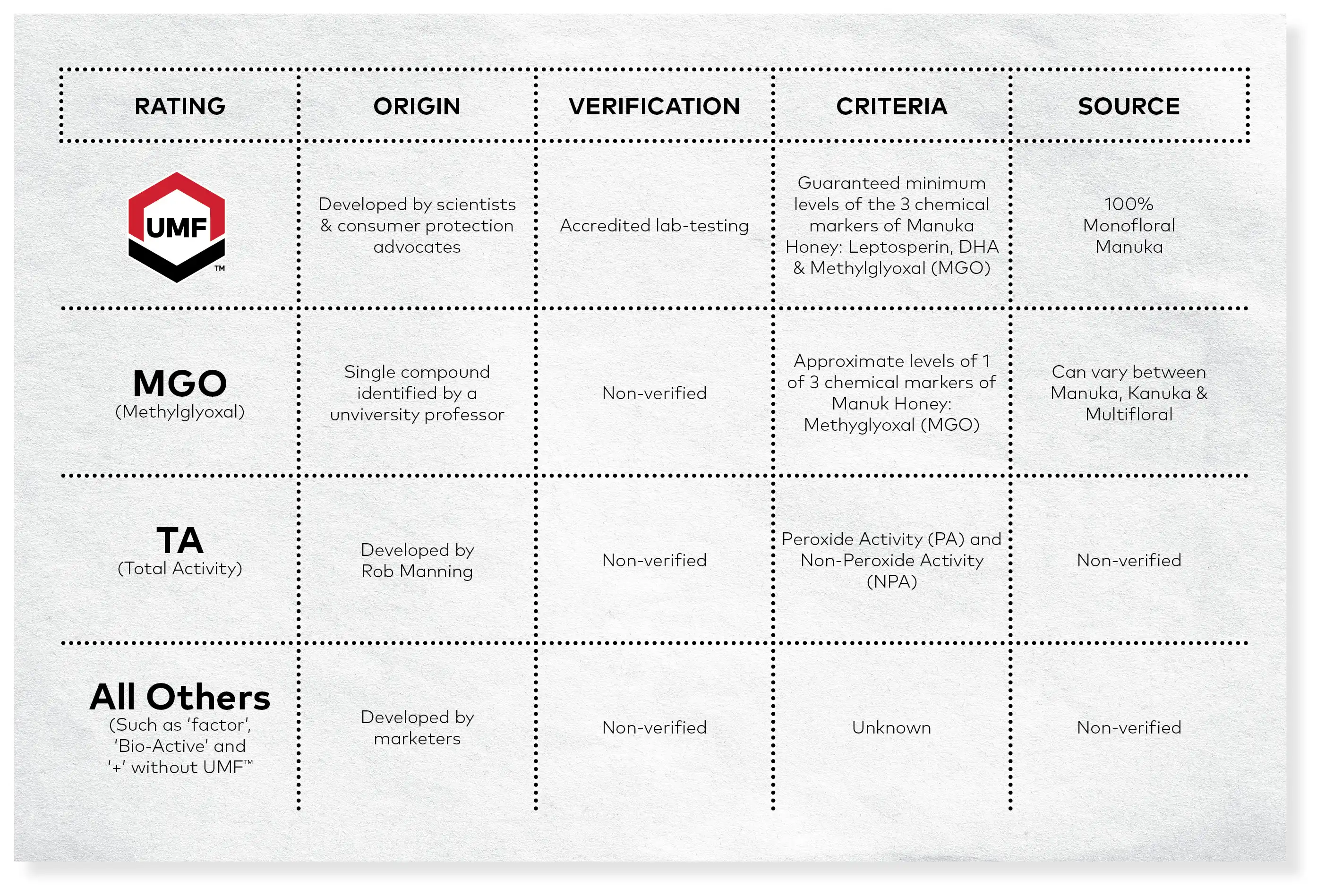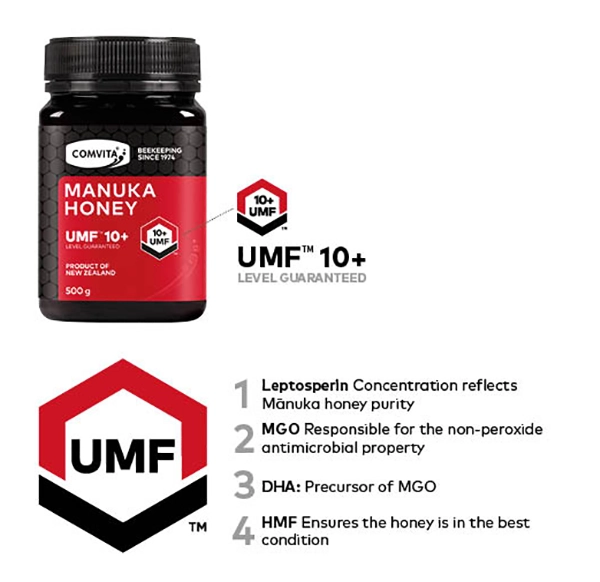
Order Confirmed
We’re sorry, the page you requested could not be found.
Mānuka Honey is a very special kind of honey that’s highly prized by naturopaths, dieticians, athletes and natural health consumers around the world. They follow in the footsteps of the indigenous Māori people of New Zealand who have used and valued the benefits of Mānuka Honey for centuries.
But what makes Mānuka Honey so special? Where does genuine Mānuka Honey come from? What are Mānuka Honey’s benefits? Keep reading to discover the story behind this very special gift from Mother Nature and why its pure natural source and strict grading system really do matter.
The origin of Mānuka Honey
Mānuka Honey is a unique and very special honey that’s truly the ‘gold standard’ of honey. Mānuka Honey is produced from the nectar of the sweet-smelling Mānuka flower found in hills and valleys around New Zealand.
Whilst Mānuka trees can be grown in other parts of the world, they’re indigenous to New Zealand, making Aotearoa (New Zealand) Manuka’s native home.
Since Mānuka Honey can only be produced in areas abundant with native Mānuka blossoms, many of our hives are located in some of the most remote parts of New Zealand, accessible only by helicopter and hiking. This can make collecting this precious nectar challenging and is just one of the reasons that Mānuka honey is more expensive than ordinary honey.
Collected from the remote hills and valleys of New Zealand, Comvita Mānuka Honey’s exclusive source and high quality extraction help to make this honey one of a kind.
What makes Mānuka Honey different from other honeys?
Most home kitchen cupboards will contain a generic kind of squeezy-bottle honey. But as you’ve just read, genuine Mānuka Honey is harvested by honey bees from the nectar of the Mānuka flower, a scarce and natural resource found only in New Zealand. It’s unique because it contains special properties that may help to support digestion, health, healing and even to soothe and moisturize skin and hair.
Unlike most other varieties of honey, which can be collected throughout much of the year, Mānuka Honey is a limited resource because the trees only flower for between 2 to 6 weeks each year. This means our busy bees only have a short window of time to collect the precious nectar and work their magic to create this rare and sought after honey!
What are the unique components of Mānuka Honey?
Rich in amino acids, vitamins, antioxidants, minerals, proteins, carbohydrates, and bioactive compounds, Mānuka Honey is a ‘super food’ that’s at the forefront of natural health sciences. No other honey has the volume or complexity of natural components at work like New Zealand Mānuka Honey.
How does Mānuka Honey taste?
Thick, rich and delicious, with a characteristic dark cream to dark brown colour, Mānuka Honey has long been admired as an exceptional honey with a distinct, complex flavour and rich aroma unlike any other honey in the world.
The higher the UMFᵀᴹ grading, the richer and more ‘savoury’ the honey, and the higher its health-supporting properties, which helps explain why premium UMFᵀᴹ 15+ or UMFᵀᴹ 20+ Mānuka Honey is in such high demand.

No other honey has the volume or complexity of natural components at work as New Zealand Mānuka Honey.
What are the benefits of Mānuka Honey?
Mānuka Honey’s key natural compounds offer sweet benefits for both the inside and outside of your body. Nature’s most powerful honey can be used for:
• Daily immune support
• Aiding digestive and gut health
• Antioxidant protection
• Soothing coughs and sore throats
• Natural pre-workout energy boost
• DIY skincare to support glowing complexion
• Single-ingredient, antibacterial face mask for acne-prone skin
• As a beneficial sweetener alternative for teas and coffee
Discover more of the super-powered properties packed into every jar of Comvita Mānuka Honey.
The UMF™ quality mark on a jar of honey ensures you’re buying natural, unadulterated Mānuka Honey from New Zealand.
Mānuka Honey grading systems: what are UMF™ and MGO?
With so many brands, confusing labelling and mixed marketing messages out there these days, it can be very hard to tell the difference between authentic Mānuka Honey and marketing hype.
Some brands are labelled with terms like “Bio-Active”, “Active”, or “Factor”, with numbers ranging from 5 to 500. And, in some cases, honey producers are making authenticity claims, even though their honey isn’t tested or verified.
There are a variety of grading systems to look for today – the two most common being UMF™ and MGO. Here at Comvita, we believe the most important standard to look for is UMF™ (Unique Mānuka Factor), the strictest quality trademark identifying natural, unadulterated Mānuka Honey.
The UMF™ number (5+, 10+, 15+, 20+ etc) represents four unique signature compounds that ensure purity and quality. These are:
MGO or Methylglyoxal is the compound chiefly responsible for the antibacterial property of Mānuka Honey and forms the basis of the UMF™ grading system.
Leptosperin is found in the nectar of Mānuka flowers and is the most discerning characteristic that reflects Mānuka Honey purity and distinguishes it from other honey types.
DHA Research has shown that the MGO in New Zealand Mānuka Honey originates from the chemical compound Dihydroxyacetone (DHA), which is present in the nectar of Mānuka flowers to varying degrees.
HMF or ‘Hydroxymethylfurfural’ is also found in the nectar of the Mānuka flowers and converts into MGO once the bees gather the nectar and turn it into honey.
The four important compounds that measure the quality of your Mānuka Honey.
The Mānuka Honey MGO rating explained
MGO or methylglyoxal is a unique, naturally-occurring chemical compound found in Mānuka Honey that gives it its highly prized antibacterial properties and makes it one of the most sought after honeys in the world.
While MGO is one of the four unique compounds that can be used to identify the purest and best Mānuka Honey (as shown above), The MGO grading system solely measures the amount of Methylglyoxal present in Mānuka Honey (in mg/kg). However, synthetic MGO can be manufactured and added into honey to create ‘fake’ Mānuka Honey.
Which means that just measuring MGO alone doesn’t give you sufficient assurance of the authenticity, purity and quality of the Mānuka Honey you’re buying.
UMF™ – the strictest and highest Mānuka Honey standard
When it comes to rating the quality of Mānuka Honey , there really is no comparison – UMF™ is the global independent standard for Mānuka honey.
The UMF™ mark on your jar of Comvita Mānuka Honey means its quality has been independently certified for potency, purity, authenticity and freshness by the UMF™ Honey Association of New Zealand (UMFHA), the rating system backed by the New Zealand government. As well as regular monitoring, the UMFHA also conduct random sampling to ensure Mānuka Honey carrying the UMF™ mark is always true to label.
You can rest assured that every jar of genuine Comvita Mānuka Honey always carries the UMF™ trademark. In fact, no other honey is as tested and trusted as ours – plus we trace every single drop of our honey on its journey from hive to shelf.
What makes Comvita the best Mānuka Honey?
As a world leader in Mānuka Honey, nearly 50 years of beekeeping science, knowledge and care is lovingly bottled into every jar.
With a deep respect for nature, born from our pioneering and visionary beekeeping heritage and our heartfelt belief that food is the best medicine, Comvita is committed to leaving the world in a better place. We’re on a mission to help restore and strengthen the delicate balance between humans and nature, while generating positive social outcomes around the world.
Following principles of kaitiakitanga (guardianship), we plant a native tree for every jar of our Mānuka Honey sold, with 10 million trees already planted in some of New Zealand’s most fragile environments. Dedicated to bee welfare, we work to save millions of bees around the world every year, donate 1% of profits to global community partnerships and lead the way in creating a circular and carbon neutral honey business.
We believe in and stand for a world where bees, nature and people can thrive in harmony. A better world for future generations. 
Not all honey is equal! It’s important to look for the UMFᵀᴹ trademark to ensure you’re getting genuine Mãnuka Honey.
Where can I find genuine Mānuka Honey near me?
Here are four things to look out for to ensure you’re getting the ‘real deal’...
• The honey comes from New Zealand. Just like real Champagne comes from France, New Zealand’s Ministry for Primary Industries (MPI) set new standards for honey labelled as “Mānuka Honey” after August 2018.
• The honey is labelled as ‘monofloral’ (which means it comes predominantly from the Mānuka flower, ensuring its unique properties), or ‘multifloral’ (a blend of Mānuka and other New Zealand wildflowers). Either way, it should have a clearly labelled MGO rating.
• The honey has the UMF™ independent certification, guaranteeing specific levels of Mānuka’s four key compounds .
• The honey comes from real beekeepers. Choose a company with their own beekeeping operation: one that is a responsible steward to the planet and its people. Mānuka Honey is one of the Earth’s most rare and precious natural resources. Both the Mānuka Flower and honey bees are incredibly sensitive to climate changes, so it matters that Mānuka Honey is harvested sustainably and regenerative.
It also matters that it comes from equitable partnerships with beekeepers and New Zealand’s indigenous Māori people, who have valued the benefits of the Mānuka flower for centuries.
So now that you have all the facts on Mānuka Honey, you can start enjoying its unique and special qualities for yourself.
FAQs
What makes Mānuka Honey different from other types of honey?
Rich in amino acids, vitamins, antioxidants, minerals, proteins, carbohydrates, and bioactive compounds, Mānuka Honey is a ‘super food’ that’s at the forefront of natural health sciences. No other honey has the volume or complexity of natural components at work as New Zealand Mānuka Honey.
Genuine Mānuka Honey is harvested by honey bees from the nectar of the Mānuka flower, a scarce and natural resource found only in New Zealand. Mānuka trees only blossom for between 2 to 6 weeks each year, which is why it’s so rare and precious.
How is Mānuka Honey graded?
There are a variety of Mānuka Honey grading systems on the market, with the two most common systems being UMF™ and MGO. Here at Comvita, we believe the most important standard to look for is UMF™ (Unique Mānuka Factor), the strictest quality trademark identifying natural, unadulterated Mānuka Honey.
The UMF™ number (5+, 10+, 15+, 20+ etc) represents four unique signature compounds that ensure purity and quality – and the higher the number, the higher the Mānuka Honey’s purity and potency. You’ll find the UMF™ trademark on every jar of genuine Comvita Mānuka Honey.
Where to buy Mānuka Honey?
High-quality Mānuka Honey can be found in most health stores, department stores and most supermarkets. Alternatively, you can buy Comvita Mānuka Honey directly from us online, so you know you’re getting the genuine article sent to you, from our hives to your hands.
Discover the difference of our Manuka Honey, learn the latest health and wellness tips, find recipes and more.

We’re sorry, the page you requested could not be found.